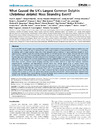Please use this identifier to cite or link to this item:
https://accedacris.ulpgc.es/jspui/handle/10553/47513
| Title: | What Caused the UK's Largest Common Dolphin (Delphinus delphis) Mass Stranding Event? | Authors: | Jepson, Paul D. Deaville, Robert C. Acevedo Whitehouse, Karina Alethya Barnett, James E. F. Brownlow, Andrew C. Brownell, Robert L. Jr Clare, Frances C. Davison, Nicholas J. Law, Richard J. Loveridge, Jan Macgregor, Shaheed Karl Morris, Steven Murphy, Sinéad Penrose, Rod Perkins, Matthew W. Pinn, Eunice Seibel, Henrike Siebert, Ursula Sierra Pulpillo, Eva María Simpson, Victor Tasker, Mark L. Tregenza, Nick Cunningham, Andrew A. Fernández Rodríguez, Antonio Jesús |
UNESCO Clasification: | 3105 Peces y fauna silvestre 310512 Ordenación y conservación de la fauna silvestre |
Keywords: | Bottle-Nosed Dolphins Porpoises Phocoena-Phocoena Gas-Bubble Lesions Tursiops-Truncatus Polychlorinated-Biphenyls, et al |
Issue Date: | 2013 | Journal: | PLoS ONE | Abstract: | On 9 June 2008, the UK's largest mass stranding event (MSE) of short-beaked common dolphins (Delphinus delphis) occurred in Falmouth Bay, Cornwall. At least 26 dolphins died, and a similar number was refloated/herded back to sea. On necropsy, all dolphins were in good nutritive status with empty stomachs and no evidence of known infectious disease or acute physical injury. Auditory tissues were grossly normal (26/26) but had microscopic haemorrhages (5/5) and mild otitis media (1/5) in the freshest cases. Five lactating adult dolphins, one immature male, and one immature female tested were free of harmful algal toxins and had low chemical pollutant levels. Pathological evidence of mud/seawater inhalation (11/26), local tide cycle, and the relative lack of renal myoglobinuria (26/26) suggested MSE onset on a rising tide between 06: 30 and 08: 21 hrs (9 June). Potential causes excluded or considered highly unlikely included infectious disease, gas/fat embolism, boat strike, by-catch, predator attack, foraging unusually close to shore, chemical or algal toxin exposure, abnormal weather/climatic conditions, and high-intensity acoustic inputs from seismic airgun arrays or natural sources (e. g., earthquakes). International naval exercises did occur in close proximity to the MSE with the most intense part of the exercises (including mid-frequency sonars) occurring four days before the MSE and resuming with helicopter exercises on the morning of the MSE. The MSE may therefore have been a "two-stage process'' where a group of normally pelagic dolphins entered Falmouth Bay and, after 3-4 days in/around the Bay, a second acoustic/disturbance event occurred causing them to strand en masse. This spatial and temporal association with the MSE, previous associations between naval activities and cetacean MSEs, and an absence of other identifiable factors known to cause cetacean MSEs, indicates naval activity to be the most probable cause of the Falmouth Bay MSE. | URI: | https://accedacris.ulpgc.es/handle/10553/47513 | ISSN: | 1932-6203 | DOI: | 10.1371/journal.pone.0060953 | Source: | Plos One [ISSN 1932-6203], v. 8 (4) |
| Appears in Collections: | Artículos |
SCOPUSTM
Citations
41
checked on Jun 8, 2025
WEB OF SCIENCETM
Citations
42
checked on Jun 8, 2025
Page view(s)
98
checked on Aug 17, 2024
Download(s)
77
checked on Aug 17, 2024
Google ScholarTM
Check
Altmetric
Share
Export metadata
Items in accedaCRIS are protected by copyright, with all rights reserved, unless otherwise indicated.
